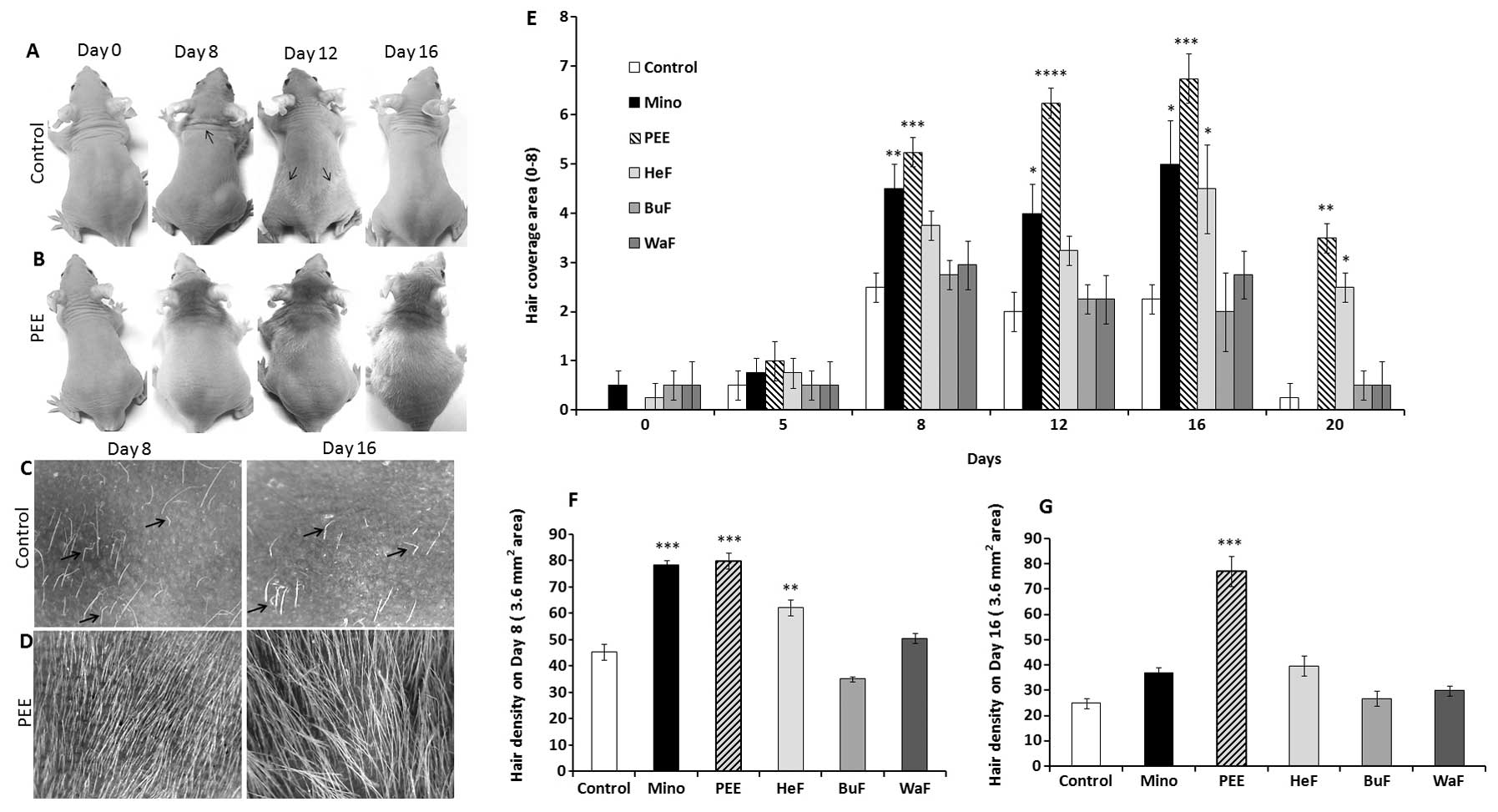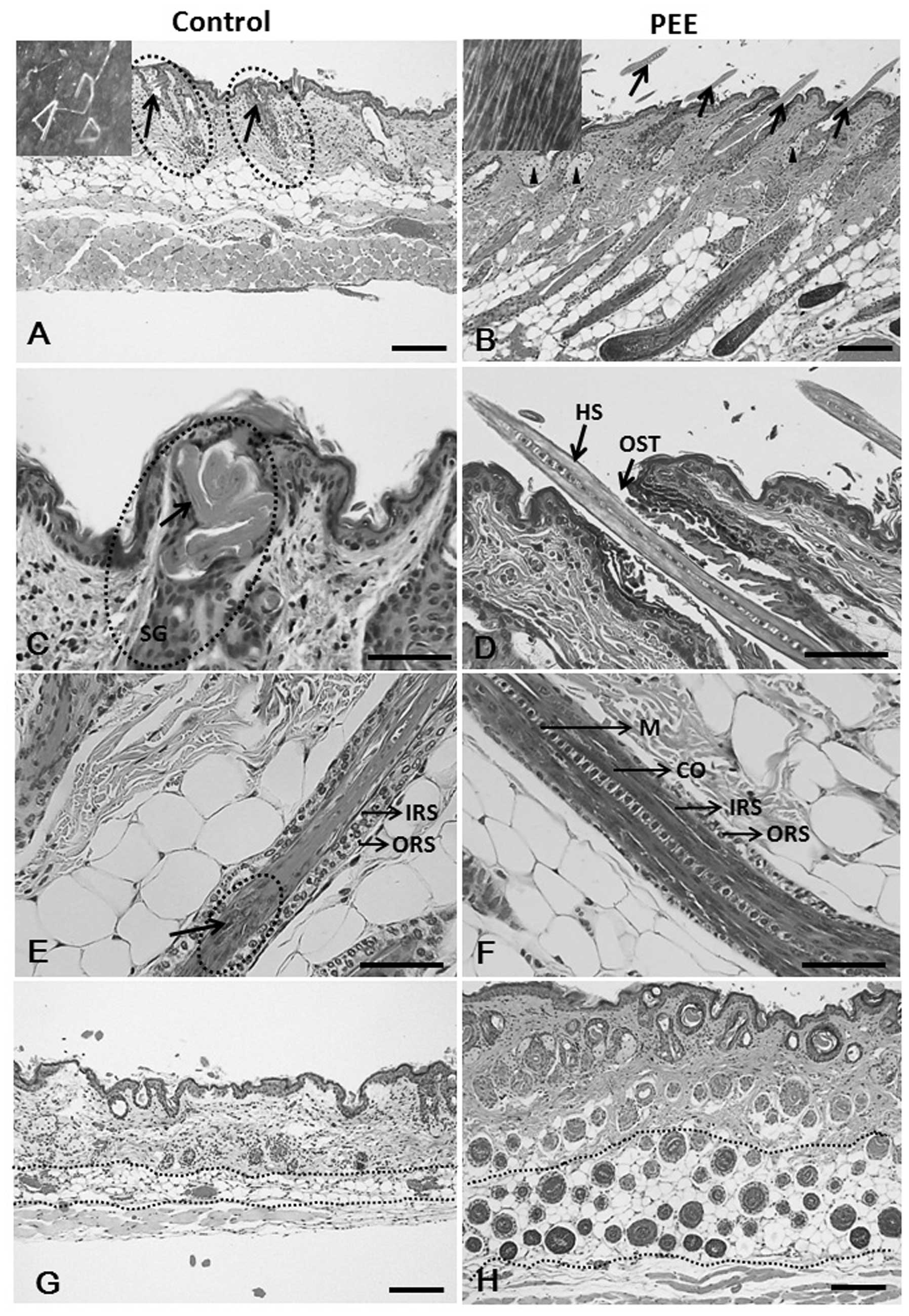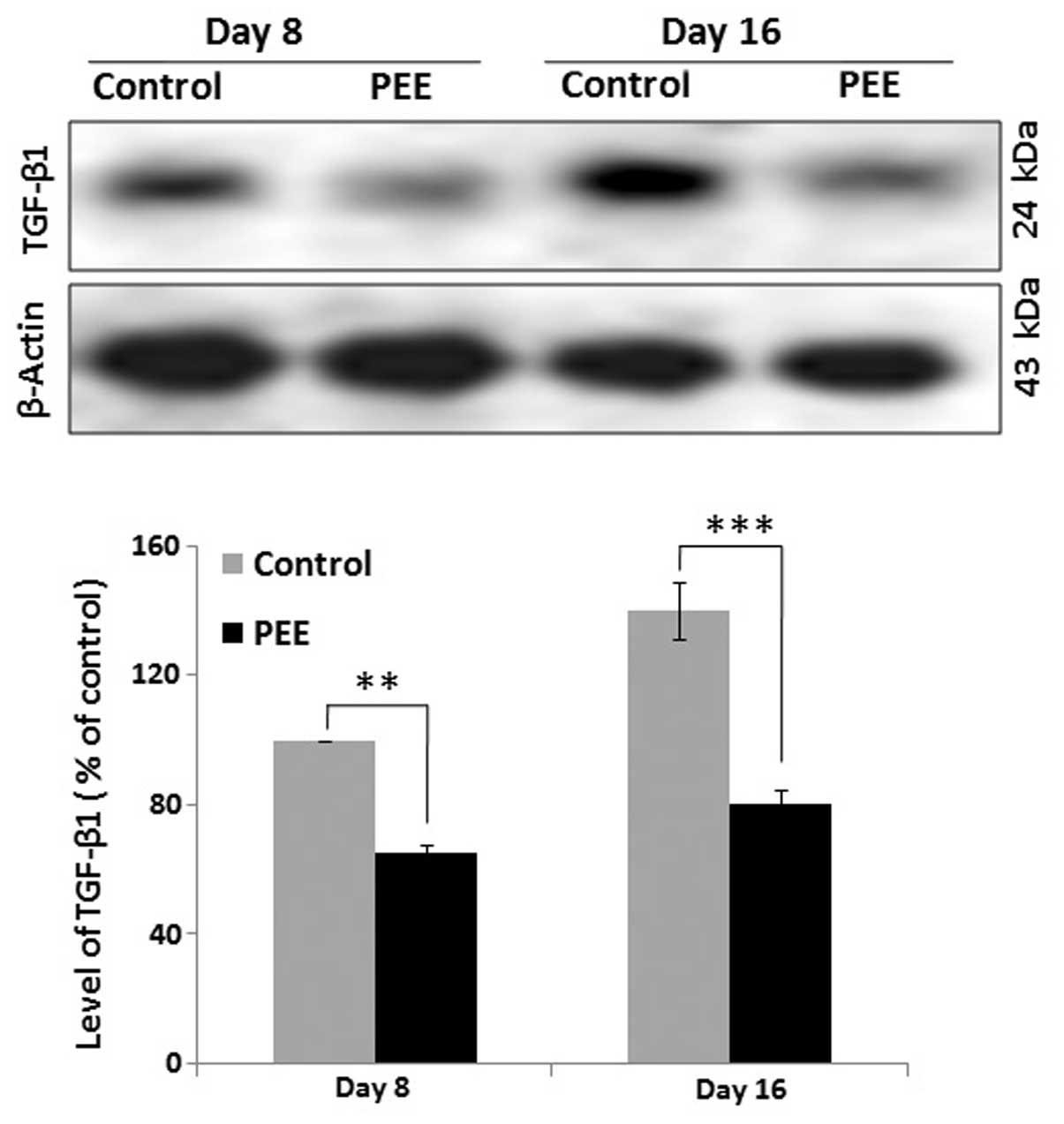|
1
|
Paus R: Control of the hair cycle and hair
diseases as cycling disorders. Curr Opin Dermatol. 3:248–258.
1996.
|
|
2
|
Paus R: Principles of hair cycle control.
J Dermatol. 25:793–802. 1998.
|
|
3
|
Rishikaysh P, Dev K, Diaz D, Qureshi WM,
Filip S and Mokry J: Signaling involved in hair follicle
morphogenesis and development. Int J Mol Sci. 15:1647–1670. 2014.
View Article : Google Scholar : PubMed/NCBI
|
|
4
|
Sellheyer K, Bickenbach JR, Rothnagel JA,
Bundman D, Longley MA, Krieg T, Roche NS, Roberts AB and Roop DR:
Inhibition of skin development by over expression of transforming
growth factor beta 1 in the epidermis of transgenic mice. Proc Natl
Acad Sci USA. 90:5237–5241. 1993. View Article : Google Scholar
|
|
5
|
Foitzik K, Lindner G, Mueller-Roever S,
Maurer M, Botchkareva N, Botchkarev V, Handjiski B, Metz M, Hibino
T, Soma T, Dotto GP and Paus R: Control of murine hair follicle
regression (catagen) by TGF-beta1 in vivo. FASEB J. 14:752–760.
2000.PubMed/NCBI
|
|
6
|
Flanagan SP: ‘Nude’ a new hairless gene
with pleiotropic effects in the mouse. Genet Res. 8:295–309. 1966.
View Article : Google Scholar : PubMed/NCBI
|
|
7
|
Pantelouris EM: Athymic development in the
mouse. Differentiation. 1:437–450. 1973. View Article : Google Scholar : PubMed/NCBI
|
|
8
|
Köpf-Maier P, Mboneko VF and Merker HJ:
Nude mice are not hairless. A morphological study. Acta Anat
(Basel). 139:178–190. 1990. View Article : Google Scholar
|
|
9
|
Mecklenburg L, Nakamura M, Sundberg JP and
Paus R: The nude mouse skin phenotype: the role of Foxn1 in hair
follicle development and cycling. Exp Mol Pathol. 71:171–178. 2001.
View Article : Google Scholar : PubMed/NCBI
|
|
10
|
Mecklenburg L, Tychsen B and Paus R:
Learning from nudity: lessons from the nude phenotype. Exp
Dermatol. 14:797–810. 2005. View Article : Google Scholar : PubMed/NCBI
|
|
11
|
Gafter-Gvili A, Sredni B, Gal R, Gafter U
and Kalechman Y: Cyclosporin A-induced hair growth in mice is
associated with inhibition of calcineurin-dependent activation of
NFAT in follicular keratinocytes. Am J Physiol Cell Physiol.
284:C1593–C1603. 2003. View Article : Google Scholar : PubMed/NCBI
|
|
12
|
Danilenko DM, Ring BD, Yanagihara D,
Benson W, Wiemann B, Starnes CO and Pierce GF: Keratinocyte growth
factor is an important endogenous mediator of hair follicle growth,
development, and differentiation. Normalization of the nu/nu
follicular differentiation defect and amelioration of
chemotherapy-induced alopecia. Am J Pathol. 147:145–154.
1995.PubMed/NCBI
|
|
13
|
Sredni B, Gal R, Cohen IJ, Dazard JE,
Givol D, Gafter U, Motro B, Eliyahu S, Albeck M, Lander HM and
Kalechman Y: Hair growth induction by the Tellurium immunomodulator
AS101: association with delayed terminal differentiation of
follicular keratinocytes and ras-dependent up-regulation of KGF
expression. FASEB J. 18:400–402. 2004.
|
|
14
|
Liu QM, Zhao HY, Zhong XK and Jiang JG:
Eclipta prostrata L. phytochemicals: isolation, structure
elucidation, and their antitumor activity. Food Chem Toxicol.
50:4016–4022. 2012. View Article : Google Scholar : PubMed/NCBI
|
|
15
|
Manvar D, Mishra M, Kumar S and Pandey VN:
Identification and evaluation of anti Hepatitis C virus
phytochemicals from Eclipta alba. J Ethnopharmacol. 144:545–554.
2012. View Article : Google Scholar : PubMed/NCBI
|
|
16
|
Chaudhary H, Dhuna V, Singh J, Kamboj SS
and Seshadri S: Evaluation of hydro-alcoholic extract of Eclipta
alba for its anticancer potential: an in vitro study. J
Ethnopharmacol. 136:363–367. 2011. View Article : Google Scholar : PubMed/NCBI
|
|
17
|
Roy RK, Thakur M and Dixit VK: Hair growth
promoting activity of Eclipta alba in male albino rats. Arch
Dermatol Res. 300:357–364. 2008. View Article : Google Scholar : PubMed/NCBI
|
|
18
|
Datta K, Singh AT, Mukherjee A, Bhat B,
Ramesh B and Burman AC: Eclipta alba extract with potential for
hair growth promoting activity. J Ethnopharmacol. 124:450–456.
2009. View Article : Google Scholar : PubMed/NCBI
|
|
19
|
Militzer K: Hair Growth pattern in nude
mice. Cells Tissues Organs. 168:285–294. 2001. View Article : Google Scholar : PubMed/NCBI
|
|
20
|
Schlake T, Schorpp M, Maul-Pavicic A,
Malashenko AM and Boehm T: Forkhead/winged-helix transcription
factor Whn regulates hair keratin gene expression: molecular
analysis of the nude skin phenotype. Dev Dyn. 217:368–376. 2000.
View Article : Google Scholar : PubMed/NCBI
|
|
21
|
Hozumi Y, Imaizumi T and Kondo S: Effect
of cyclosporin on hair-existing area of nude mice. J Dermatol Sci.
7(Suppl): S33–S38. 1994. View Article : Google Scholar : PubMed/NCBI
|
|
22
|
Panteleyev AA, Paus R, Ahmad W, Sundberg
JP and Christiano AM: Molecular and functional aspects of the
hairless (hr) gene in laboratory rodents and humans. Exp Dermatol.
7:249–267. 1998. View Article : Google Scholar : PubMed/NCBI
|
|
23
|
Fuchs E: Epidermal differentiation and
keratin gene expression. J Cell Sci Suppl. 17:197–208. 1993.
View Article : Google Scholar : PubMed/NCBI
|
|
24
|
Paus R, Foitzik K, Welker P, Bulfone-Paus
S and Eichmüller S: Transforming growth factor-beta receptor type I
and type II expression during murine hair follicle development and
cycling. J Invest Dermatol. 109:518–526. 1997. View Article : Google Scholar : PubMed/NCBI
|
|
25
|
Hardy MH: The secret life of the hair
follicle. Trends Genet. 8:55–61. 1992. View Article : Google Scholar : PubMed/NCBI
|
|
26
|
Soma T, Dohrmann CE, Hibino T and Raftery
LA: Profile of transforming growth factor-beta responses during the
murine hair cycle. J Invest Dermatol. 121:969–975. 2003. View Article : Google Scholar
|
|
27
|
Soma T, Tsuji Y and Hibino T: Involvement
of transforming growth factor beta2 in catagen induction during the
human hair cycle. J Invest Dermatol. 118:993–997. 2002. View Article : Google Scholar : PubMed/NCBI
|
|
28
|
Tsuji Y, Denda S, Soma T, Raftery L, Momoi
T and Hibino T: A potential suppressor of TGF-beta delays catagen
progression in hair follicles. J Investig Dermatol Symp Proc.
8:65–68. 2003. View Article : Google Scholar : PubMed/NCBI
|














